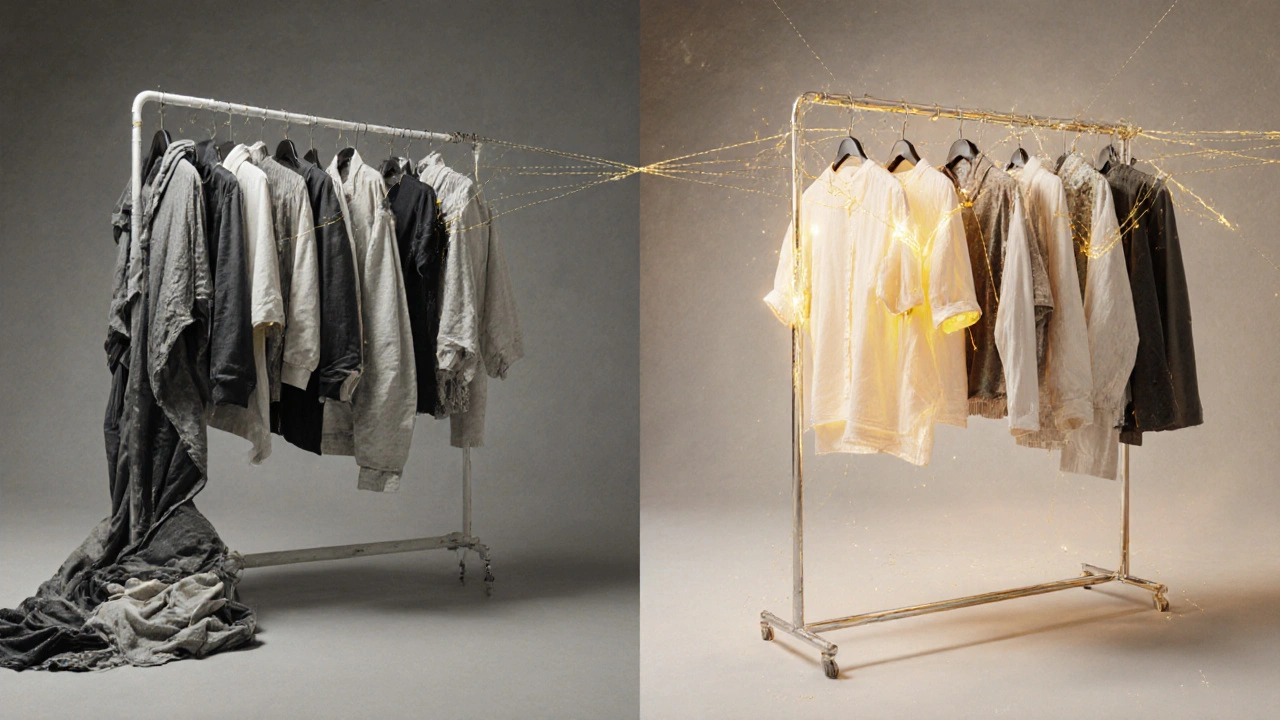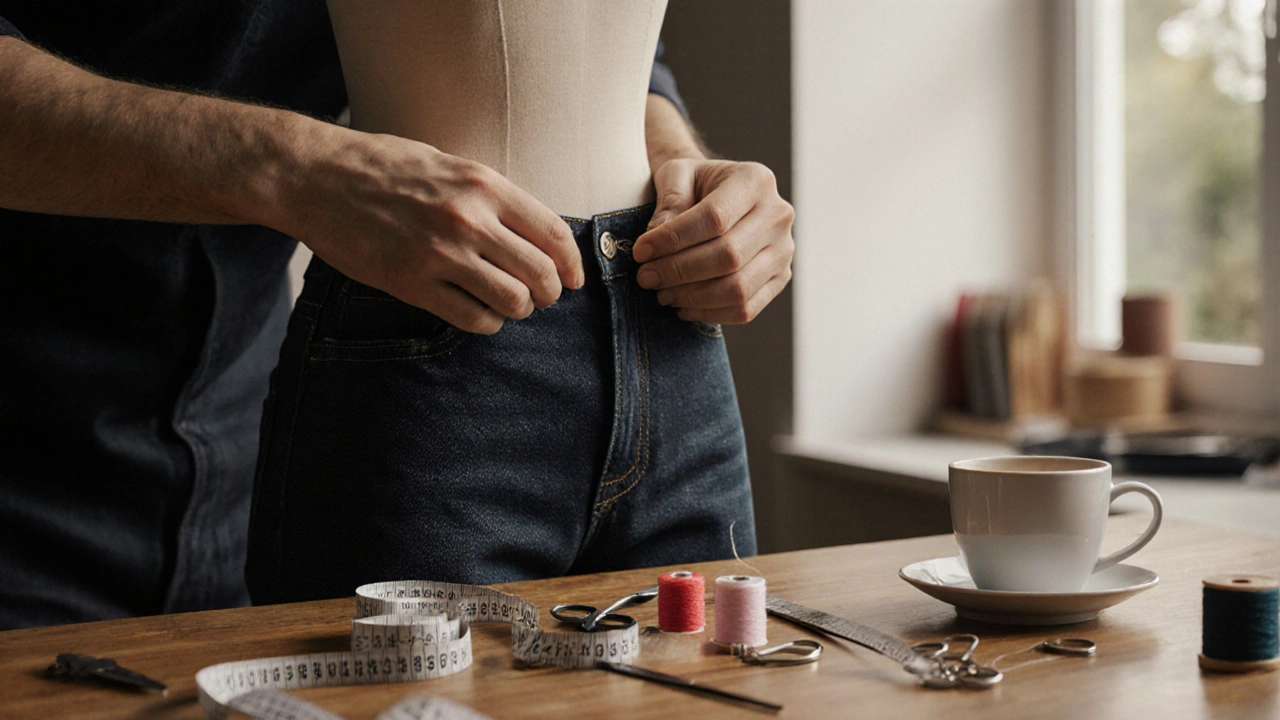Have you ever pulled out a shirt you love-only to realize it doesn’t fit right anymore? The sleeves are too long, the waist gapes, or the hem hits awkwardly above your ankle? You might think it’s time to let it go. But what if you could bring it back to life with just a few stitches?
Most people toss clothes they don’t fit perfectly. But the truth is, a well-fitted garment feels like it was made for you-even if it wasn’t. Tailoring and alterations aren’t just for formal wear or expensive suits. They’re the quiet secret behind polished, confident style. And they’re one of the most sustainable things you can do for your wardrobe.
Why Fit Matters More Than You Think
Fit isn’t about looking skinny. It’s about comfort, movement, and how clothes make you feel. A shirt that’s too tight in the shoulders pulls when you reach for something on a high shelf. Pants that are too loose in the seat bunch up when you sit. That’s not just annoying-it’s exhausting. You spend your day adjusting your clothes instead of living your day.
Studies show people who wear well-fitting clothes report higher confidence levels and feel more in control of their appearance. That’s not magic. It’s physics. Clothes that move with your body don’t fight you. They disappear. And suddenly, you’re not thinking about your outfit-you’re thinking about your life.
Here’s the kicker: you don’t need to buy new clothes to get this feeling. You just need to fix the ones you already own.
What Alterations Actually Do
Alterations are small changes that make a big difference. They’re not about redesigning your clothes-they’re about fine-tuning them. Think of it like tuning a guitar. The instrument is still the same. But now it sounds right.
Here are the most common and impactful alterations:
- Hemming pants or skirts: This is the #1 fix. Most off-the-rack pants are made for someone 5’8” or taller. If you’re shorter, your pants drag. Hemming them to the right length instantly makes you look taller and sharper.
- Taking in the waist: Whether it’s jeans, trousers, or a dress, a slightly loose waistline makes clothes look sloppy. Taking in the waist by even half an inch creates a clean line from hip to thigh.
- Shortening sleeves: Long sleeves on a shirt or blazer look lazy. Shortening them to end at the base of your thumb (where your wrist bone is) gives structure and polish.
- Narrowing shoulders: If your shoulders look like they’re hanging off the jacket, it’s not your posture-it’s the cut. Narrowing the shoulder seam by a quarter inch can make a bulky jacket look tailored.
- Adjusting armholes: Armholes that are too tight restrict movement. Too loose, and the shirt gapes. A skilled tailor can adjust this without changing the overall shape.
These aren’t fancy fixes. They’re basic. And they cost less than a coffee at a trendy café in Brooklyn.
How Much Does Tailoring Really Cost?
People assume tailoring is expensive. It’s not. Here’s what you’ll actually pay in New York City in 2025:
| Alteration | Average Cost | Time to Complete |
|---|---|---|
| Hem pants | $15-$25 | 1-2 days |
| Take in waist (pants or skirt) | $20-$35 | 2-3 days |
| Shorten sleeves | $15-$25 | 1-2 days |
| Narrow shoulders (blazer) | $40-$60 | 3-5 days |
| Adjust armholes | $30-$50 | 2-4 days |
Compare that to buying a new pair of jeans: $80-$150. Or a blazer: $120-$300. You’re not spending more-you’re spending smarter.
And here’s the real math: if you fix three items a year, you’re saving $300-$600 annually. That’s not just money. That’s fewer clothes in landfills, less shopping stress, and a closet that actually works for you.

Which Clothes Are Worth Altering?
Not everything needs fixing. Some things are better off replaced. So how do you decide?
Ask yourself these three questions:
- Do I wear it at least once a month? If yes, it’s worth altering. Even if it’s just a favorite sweater you wear on weekends.
- Is the fabric good? Cotton, wool, linen, and silk respond well to tailoring. Cheap polyester blends? They might not hold a new hem or seam. If it’s thin, shiny, or stretches out after one wash, skip it.
- Does it have emotional value? That dress you wore to your sister’s wedding? The jacket your dad gave you? These aren’t just clothes-they’re memories. Fixing them keeps those moments alive.
Here’s a quick rule of thumb: if you’d buy it again today, fix it. If not, donate it. Simple.
Where to Get Tailoring Done
You don’t need to go to a fancy tailor in Manhattan. In fact, some of the best work comes from small shops in quiet neighborhoods.
Look for:
- Local dry cleaners with alteration services: Many have been doing this for decades. Ask if they do custom work or just basic hems.
- Independent tailors in strip malls: They’re often cheaper than boutiques and more patient than big stores.
- Community sewing circles: In Brooklyn and Queens, some libraries and community centers host monthly sewing nights. Volunteers help with simple fixes for free or a small donation.
- Online tailoring services: Companies like The Tailory or Indochino let you mail in clothes, send measurements, and get them back fitted. Great for remote areas or if you’re short on time.
Pro tip: Bring the shoes you’ll wear with the garment. A hem that looks perfect in flats might drag with heels. Always try on with your actual footwear.
How to Start Your First Alteration Project
Feeling overwhelmed? Start small.
Here’s your 3-step plan:
- Pick one item: Choose something you wear often but hate because it doesn’t fit. A pair of jeans? A shirt? A blazer? Doesn’t matter. Just pick one.
- Take it to a tailor: Don’t call ahead. Just walk in. Say: “I love this piece, but it doesn’t fit right. Can you help me fix it?” Most tailors will ask you a few questions and give you a quote on the spot.
- Wear it again: When you get it back, wear it out. Walk around. Sit down. Raise your arms. Feel how it moves. That’s the moment you realize: this is what good fit feels like.
After that, you’ll start seeing every loose seam, every dragging hem, every baggy shoulder as a chance-not a problem.

Why This Is Sustainable Fashion
Fast fashion thrives on disposability. But your clothes don’t have to be disposable. Altering them breaks that cycle.
According to the EPA, Americans throw away 11.3 million tons of clothing each year. Less than 15% is recycled. The rest ends up in landfills or incinerators.
Fixing one pair of jeans saves 2,000 gallons of water-that’s what it takes to make a new pair from scratch. Fixing five items a year? That’s 10,000 gallons saved. That’s not a drop in the bucket. That’s a wave.
Tailoring isn’t just about saving clothes. It’s about saving resources. It’s about slowing down. It’s about choosing quality over quantity.
What Happens When You Start Altering
Here’s what you’ll notice after a few fixes:
- You stop buying new clothes just to replace old ones.
- You start noticing how clothes fit on other people-and you realize most of them are wearing something that doesn’t quite work.
- You feel more confident because your clothes don’t distract you anymore.
- You start seeing your closet as a collection of possibilities, not clutter.
One woman I know in Queens had three dresses she loved but never wore because they were too big after losing weight. She got them altered for under $75 total. Now she wears them weekly. She told me: “I didn’t realize how much I’d missed feeling like myself.”
That’s the real power of tailoring. It doesn’t change your clothes. It changes how you feel in them.
Final Thought: Your Closet Doesn’t Need More Clothes. It Needs Better Fit.
You don’t need a bigger closet. You need a better-fitting one.
Next time you look at a piece you’ve been avoiding, don’t think, “I should get rid of this.” Think, “What if I could make this perfect?”
It’s not about being perfect. It’s about being comfortable. And sometimes, all it takes is a few stitches to feel like yourself again.
How long do alterations usually take?
Most basic alterations like hemming pants or taking in a waist take 1 to 3 days. More complex changes, like adjusting shoulders on a blazer, can take 3 to 5 days. Always ask for a timeline when you drop off your clothes. Some tailors offer rush service for an extra fee-usually $10-$20.
Can I alter clothes myself at home?
Yes, for simple fixes like shortening sleeves or hemming pants with a sewing machine. But if you’re new to sewing, start with inexpensive items. A $5 thrift-store shirt is a better practice piece than your favorite blazer. For anything involving darts, shoulder seams, or armholes, leave it to a professional. One wrong stitch can ruin the whole garment.
What if my clothes are too big after weight loss?
That’s one of the most common reasons people get alterations. Taking in the waist, hips, and bust is straightforward for most tailors. If the garment is significantly oversized, they might need to re-cut seams or add new darts. It’s more work, but still cheaper than replacing the whole item. Many tailors specialize in post-weight-loss tailoring.
Do all dry cleaners do alterations?
No. Many only do basic hems. Ask if they have an in-house tailor or if they send work out. If they say, “We just press clothes,” move on. Look for places that mention “alterations” on their sign or website. A good tailor will ask you how you wear the garment and show you pins before stitching.
Are alterations worth it for cheap clothes?
Only if the fabric is decent and you wear it often. A $20 shirt made of thin, stretchy polyester won’t hold up after a few washes-even with a perfect hem. But a $40 cotton shirt from a discount store? If it fits your style and you wear it weekly, spending $25 to fix it makes perfect sense. Focus on quality over price.
How often should I get my clothes altered?
You don’t need to alter clothes regularly. Once is usually enough-unless your body changes significantly. Weight gain or loss, pregnancy, or aging can affect fit. But if your size stays stable, a good alteration lasts years. Think of it as a one-time investment in your wardrobe.


Write a comment